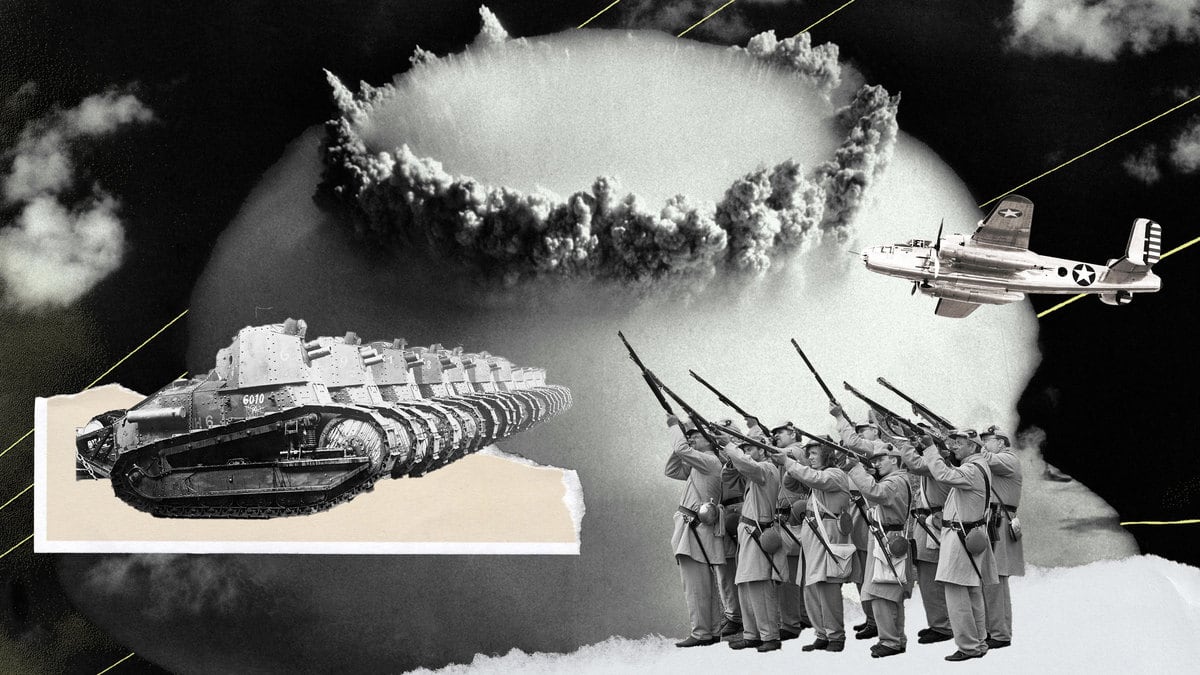Nothing has changed the face of modern war so much as technological innovation, military and otherwise. Martin Van Creveld, a brilliant Israeli historian, tells us that “technology affects warfare like waves of a stone thrown into a pond. The disturbance is strongest at the point of impact; the further the ripples spread, the weaker and less noticeable they become. And the further they go, the more likely they are to lose their identity by becoming intermixed with ripples thrown up by other stones.”
The most revolutionary technologies to affect warfare emerged between the end of the Napoleonic wars in 1815, and the end of World War II in 1945, according to leading military historians. The rifled musket of the 1830s spelled the beginning of the end for tight tactical formations, such as the Roman wedge and the Napoleonic column, as well as the brightly colored uniforms that had defined Western warfare since the rise of nation states. By the 1860s, the repeating rifle made bayonet charges obsolete, but American Civil War generals failed to recognize this fact, and the result was catastrophic losses in combat.
The widespread use of explosive artillery shells in the 1850s ensured the demise of two ancient and venerable military institutions, the masonry fort and the wooden-hulled sailing ship. Yet, it took more than 20 years and several other non-military technological innovations before modern steel-hulled navies could emerge. These were all products of England’s Industrial Revolution: the steam engine, the screw propeller, and large-scale steel production.
Two other innovations of the Industrial Revolution vastly expanded both the scale and scope of warfare. The railroad and the telegraph permitted commanders to move vast quantities of troops and materiel to the battlefield, and to keep track of widely dispersed regiments and divisions for the first time. At Gettysburg, Generals Meade and Lee presided over some 200,000 fighting men. At the Somme on the Western Front in 1916, more than 3 million soldiers squared off against one another. One million became casualties over the battle’s 140 days, and the outcome was a draw.
According to a fascinating new history of weapons technology, Firepower by Paul D. Lockhart, in the half-century between the Franco-Prussian war of 1870-71 and the end of World War I in 1918, “weapons technology advanced further and faster than it ever had before... It was a period of profound, rapid, even violent change in the killing potential of weaponry, made possible by the confluence of brilliant engineers, great leaps forward in the disciplines of chemistry and physics, and--perhaps most importantly—an arms race propelled by governments aggressively seeking out every possible advantage they could steal on their enemies, neighbors, and rivals.”
By the end of the “war to end all wars,” three transformative new weapons had emerged: the tank, the warplane, and the torpedo-bearing submarine. Senior strategists and commanders now had to deal with campaigns on land, sea, and air simultaneously. But the military capabilities of the tank and the airplane were not at all clear by the time the guns fell silent in 1918. General Heinz Guderian of the Wehrmacht in World War II was the driving force behind the emergence of combined arms mobile warfare, integrating Panzer tank divisions with motorized infantry and concentrated air cover. It was called Blitzkrieg. The Germans were able to run roughshod over most of the armies in Western Europe in a mere nine months. The campaign against its powerful adversary, France, took only six weeks, despite the presence in France of almost 400,000 British soldiers.
In the Allies’ struggle to defeat the Axis powers, the United States rapidly emerged as the “arsenal of democracy,” producing more ships, planes, and tanks than any other allied nation by far, and the war was brought to an end through the use of atomic weapons, which possessed unimaginable destructive potential. The United States had spent billions to develop “the bomb.” It wasn’t long after the war that an international consensus emerged: Atomic weapons must not be used again, for the simple reason that an atomic exchange could rather quickly bring an end to all of history.
As the Cold War began to take shape in the mid-1940s, the U.S. military was universally recognized as the most powerful and technologically sophisticated force in the world by far. This remains true today, even granting China’s remarkable military rise. The Pentagon spends billions each year on technological research and development to defeat adversaries while suffering as few friendly casualties as possible. The U.S. military establishment and the policymakers who have presided over it since the beginning of the Cold War have exhibited a strong and abiding inclination to seek technological solutions to new challenges of the battlefield, rather than through tactical or strategic innovations with existing technology, or through in-depth study of the culture and way of war of its potential adversaries.
Ironically, Washington’s penchant for seeking technological solutions to military problems goes far toward explaining why the United States has such a lousy track record in fighting wars since the searing catastrophe of Vietnam. Our failures there, and in Lebanon (1983), Somalia (1993), and Afghanistan and Iraq stem largely from ignorance on the part of both policy makers and generals of our adversaries’ political dynamics, cultures, and ways of fighting.
In civil wars, insurgencies, and anarchic failing nation states, raw firepower and a technologically driven approach to warfare have often proved to be more of a problem than a solution, because such wars are primarily about gaining and maintaining control of the local population, not destroying the armed forces of the adversary. What distinguishes these conflicts from conventional fighting between national armies, wisely observes Professor Carnes Lord of the U.S. Naval War College, “is not the scale of violence as such but the fact that the violence is embedded in a political context that directly shapes and constrains it… Low intensity warfare is distinguished from other warfare by the extent to which politics dictates not merely strategy but military operations and even tactics.”
Senior U.S. political and military officials have entered these conflicts convinced that superior technology and firepower will win out. It hasn't. Indeed, candid, realistic thinking about the nature of these conflicts, both before the commitment of forces, and then during the actual fighting, has been a scarce commodity. All of which lends credence to historian Max Boot’s contention in War Made New that “technology alone rarely confers an insurmountable military edge. Even if a country figures out how to harness military power, it still needs the wisdom to know the capabilities and limitations of its war machine.”
The story of American military deployments to foreign shores since Vietnam, more often than not, is largely a story of wishful thinking, in which the extraordinary capabilities of our technology have blinded overconfident presidents, national security advisers, and generals to the limitations of military force in effecting political change in Asia, the Middle East, and Africa.
In short, for the last half a century, the United States’ extraordinary military power has been badly squandered fighting the wrong wars in the wrong places at the wrong times.






